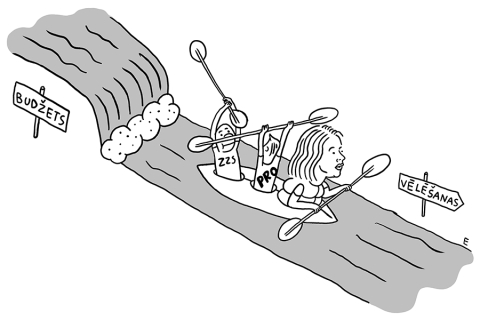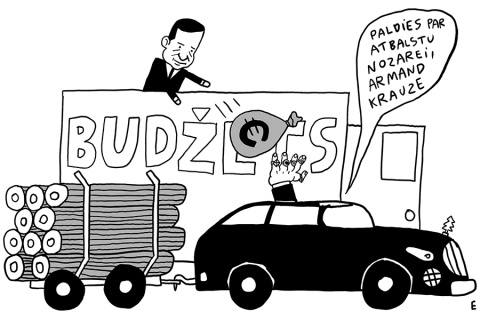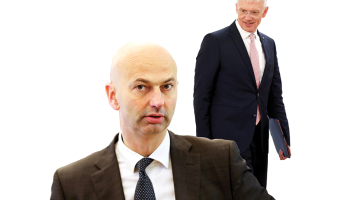Žurnāls Ir | Svarīgākais politikā, ekonomikā un kultūrā
Jaunākie raksti

Aspazijas laiks. Intervija ar rakstnieci Ingu Ābeli
Rakstniece Inga Ābele noaudusi iespaidīgu daiļliteratūras darbu — romānu Mīlamā par Aspaziju, viņas dzimtu un vēl daudz senākiem laikiem Kurzemē un Zemgalē

Mūžībā aizgājušās Noras Ikstenas fenomens latviešu kultūrā
Latviešu literatūras mūslaiku spožākā zvaigzne Nora Ikstena (1969—2026) izdzīvoja īsu, bet ārkārtīgi spilgtu mūžu gan literārā, gan personiskā nozīmē. «Pēc savas dabas esmu vitāls cilvēks, pat ja paslīd kāja, man gribas piecelties,» tā par sevi sacīja Nora

ASV aiztur divus ēnu flotes kuģus
Sadursmes Alepo
Gors paliks Rēzeknes pašvaldības pārziņā
Lasīt vairāk →Īsi par svarīgāko ik rītu — pieraksties jaunumu vēstulei Ir Svarīgākais!

Sliktie veikali. Kādas ir interneta krāpnieku viltības?
Gada nogales iepirkšanās drudzi interneta krāpnieki gaidīja, nepacietībā berzēdami rokas. Tie izlikuši lamatas gan jūsu sociālo mediju kontos, gan interneta meklētāju rezultātos. Taču pircēju muļķošana, protams, notiek cauru gadu

Aktrise Marlēna Sniega par lomu Kristenas Stjuartes debijas filmā
Jauno aktrisi Marlēnu Sniegu aizrauj pārtapšana citā cilvēkā. Pagājušajā gadā Kannu kinofestivālā pirmizrādi piedzīvoja amerikāņu aktrises Kristenas Stjuartes debijas filma Ūdens hronoloģija, kurā svarīgu lomu atveidojusi Marlēna

Ielūkojies pirmais atjaunotajā Mūkusalas ielas krasta promenādē!
Rīgas dome sola 9. janvārī svinīgi atklāt par 21 miljonu eiro atjaunoto Mūkusalas ielas krasta promenādi. Taču izrādās, ka tās centrālais skatu laukums Daugavā pretī Nacionālajai bibliotēkai šoziem iedzīvotājiem vēl nebūs pieejams
Raidieraksti
Karikatūra
Pētījumi
Bizness un ekonomika

Labāk nekā citi – AKB Industrial biznesa veiksmes stāsts
Ne vienmēr vajag izdomāt divriteni no jauna. Var darīt to pašu, ko citi, tikai labāk — pēc savas pieredzes saka Liepājas puses uzņēmuma AKB Industrial īpašnieks Aivars Krūmiņš

Zaļenieku kokaudzētavas biznesa veiksmes stāsts
Latgales puika Imants Parfenovičs sapņoja par mūziķa karjeru, taču dzīve aiznesa uz otru Latvijas malu un pavisam citu profesiju. Pirms 30 gadiem veidoto uzņēmumu dārznieks vada vēl 73 gadu vecumā

Gudrāki logi – uzņēmuma i2 biznesa veiksmes stāsts
Krista Slokenberga ģimenes uzņēmums i2 ražo logus, vienus no energoefektīvākajiem, kādi pieejami tirgū un kurus novērtē arī dizaina dēļ. Pirms to iemācījās, viņš divreiz bankrotēja
Viedokļi
Personības
Eiropā
Recenzijas
Populārākie raksti

Trampa jaunā pasaule
ASV valdība ir paziņojusi mērķi pārdalīt globālās ietekmes sfēras

Salacgrīvā suņi uzbrūk medmāsai – Ilzei vairākas operācijas, dzīvnieki joprojām savā vaļā
Divi suņi novembrī Salacgrīvā stipri sakoda medmāsu Ilzi, kura bija ieradusies pie pacientes. Viņai veiktas četras smagas operācijas, tikmēr suņi joprojām staigā brīvā vaļā, ierobežoti tikai ar elektrosētu

Pusmiljons eiro drošības naudai! Atbrīvo pusmiljarda atmazgāšanā apsūdzēto Elmāru Laizānu
Pusmiljarda eiro atmazgāšanas lietā apsūdzētais uzņēmējs Elmārs Laizāns atbrīvots no apcietinājuma. Drošības naudas apmērs — pusmiljons eiro
- Komentārs
- 11.12.2025.
- Aivars Ozoliņš
Trampa jaunā pasaule

- Dzīve
- 11.12.2025.
- Agnese Meiere
Salacgrīvā suņi uzbrūk medmāsai – Ilzei vairākas operācijas, dzīvnieki joprojām savā vaļā

- Analīze
- 11.12.2025.
- Baiba Litvina
Pusmiljons eiro drošības naudai! Atbrīvo pusmiljarda atmazgāšanā apsūdzēto Elmāru Laizānu


Ārpus rāmjiem. Kā tapa godalgotais koka bērnudārzs Salaspilī?
Koka bērnudārzs Salaspilī tapa par spīti noteikumiem, kas neļāva tādu būvēt. Šogad tas saņēma Latvijas Arhitektūras gada balvu

Vanadziņa māja Cēsīs – sapnis par viesnīcu un restorānu
Pirms septiņiem gadiem Cēsu vecpilsētas sirdī no gruvešiem atdzima leģendārā Vanadziņa māja, kurā jauni latviešu uzņēmēji cerēja piepildīt sapni par savu restorānu un viesnīciņu. Šoruden restorāns H. E. Vanadziņš pirmo reizi ieguva prestižo Michelin Bib Gourmand apbalvojumu

Minimālās algas celšana nedrīkst kļūt par “zaļo gaismu” noziedzniekiem
Valstī ik pa laikam tiek celta minimālā alga, un šādu lēmumu pieņem izpildvara – Ministru kabinets. No pirmā acu uzmetiena tā ir sociāli taisnīga un atbalstāma iniciatīva, kas paredzēta iedzīvotāju labklājības uzlabošanai. Tomēr aiz šī ekonomiskā instrumenta slēpjas arī būtiska juridiska dimensija, par kuru sabiedrība reti aizdomājas – minimālās algas celšana automātiski ietekmē vairākus krimināltiesību un administratīvās atbildības kritērijus.

Būt patiesam, nevis pareizam – intervija ar teologu Induli Paiču
Ir labi, ka garīgais gads sākas neilgi pirms Jaunā gada, saka mācītājs un teologs Indulis Paičs (46). Viņš aicina atrast brīdi, lai ieklausītos sevī, jo adventes vēsts ir — ja gribi ārējas pārmaiņas, tām vispirms jāsākas tevī









































